The Origin and Development of Eurythmy 1912–1918
GA 277a
23 August 1915, Dornach
Translated by Steiner Online Library
The Apollonian Course V
On August 23, 1915, two lessons took place: one in the morning and one in the afternoon. At the end of the morning lesson, the ether wave introduced the previous day was repeated, as can be seen from the original notes of Mieta Waller, who participated for the first time that day.
But as with everything in the development of eurythmy, later there were more possibilities – as was also the case with tone eurythmy. First there was B3.1965 movement as an interval, then as a tone, then going even further: C = fundamental tone, but every scale has a fundamental tone, so every tone can be the fundamental tone.
Word and sound
Sound appears through the whole human being. The spoken word appears in the human being.
The spoken word is expressed in the human being, the musical word is expressed through the whole human being.
The spoken word is in the human being. Sound is through the whole human being.
The sound appears in the human being. The tone is the whole human being.
Tone scale / major scale
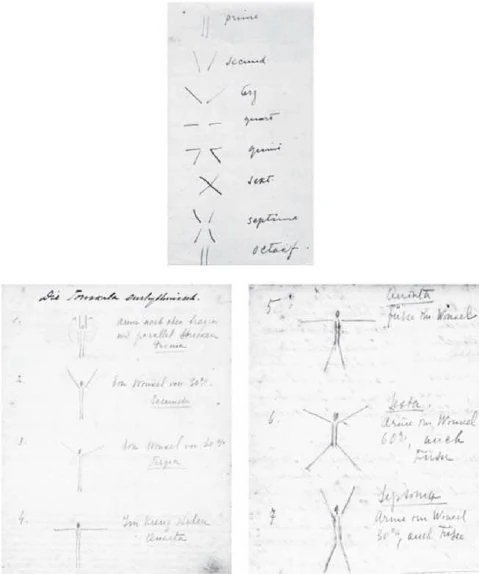
Tatiana Kisseleff, Nb // Deviations in the transcription by Johanna Mücke in ()
The eurhythmic tone scale
1. Raise your arms and stretch them parallel Prima
2. An angle of 30% Secunda
3. An angle of 60% Terzia
4. Stand with your feet together Quarta [90%]
5. Quinta Feet at an angle
6. Sexta Arms at an angle of 60%, feet (legs) too
7. Septima Arms at an angle of 30%, feet (legs) too
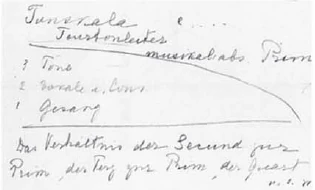
Tone scale e.... Tour[major] scale musical prime / 3rd tones 2nd vowels and consonants 1st singing / The ratio of the second to the prime, the third to the prime, the fourth, etc.
Raise your hands in a circle,
“These shapes (angles of tone eurythmy) apply to every normal key, major and minor. They are not note values, but intervals.” This is the first instruction. The second, a little later: “You must now learn to feel whether you want to use this movement as intervals or notes; it depends on the type of piece of music!” — So: C = can be the root note of C major; C: can be the fifth of F, for example; or the third of A (below); or the sixth of A (above), etc.
Now the scale: from tone to tone in degrees:
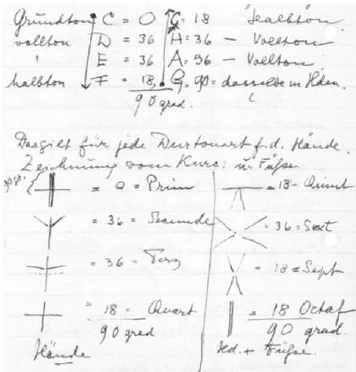
Fundamental tone C = 0 / whole tone D = 36 / whole tone E = 36 / semitone F = 18 / 90 degrees / G = the same in hands / A = 36 - whole tone / B = 36 - whole tone / C = 18 semitone
This applies to every major key for the hands and feet. / Drawing from the course: 90 degrees 0 = Prime / 36 = Second / 36 = Third / 18 = Fourth / 90 degrees / Hands / 18 - Fifth / 36 = Sixth / 18 = Seventh / 18 Octave / 90 degrees / Hands + Feet

Later, the angles were expressed by the semitones as follows: GA 2774 Prim 0° = the musical image of # / Second Arms at an angle of 36° / Sk” Third Arms at an angle of 72° / Fourth Arms at an angle of 90° / Fifth Arms remain at an angle of 90°. Legs at an angle of 30° (jump) / Sixth Arms at an angle of 54°. Legs at an angle of 60° (jump) / Seventh Arms at an angle of 18°. Legs at an angle of 30° (jump) / Octave 0° as above. (Later execution of these jumps: Fifth = small jump outwards, Sixth = slightly larger jump outwards; Seventh = back to the first jump.)
Representation in a triangle
On this occasion, Dr. Steiner also spoke of “a kind of representation in a triangle”: the person standing at the top of the triangle will sing, the person standing at the front right will make the letters, and the person standing at the front left will make the tones.
[See the illustration above]
3. Tones
2. Vowels and consonants
1. Singing
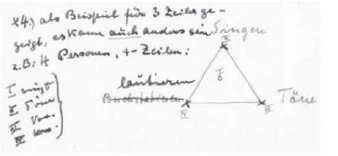
Singing / spelling / dancing sounds. The triangle
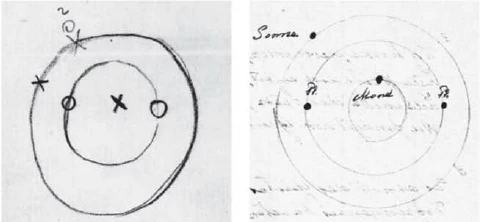
x4.) shown as an example of three lines, it can also be different,
e.g.: 4 people, 4 lines:
I sings II notes III vowels IV consonants.
Singing / notes / spelling out sounds.
Swallows = Dionysian. Dionysus is overcome by Apollo's lyre in the world poem
12 stanzas of 9 lines each, that is the cosmic poem of the world, the cosmic world poem. Dionysus is overcome by Apollo's lyre in the world poem.
And in the planetary dance, everyone had to do their entire line with all the forms. - Because I had to do the sun back then, I know this very well. - A small incident occurred during this. The sun has an interjection in both the 3rd and 6th stanzas. While practicing together, the others thought that it was not right to do as I did, lifting both feet off the ground during “O seek, O soul” and “So guide, O spirit.” “That is too Luciferic!” When Dr. Steiner arrived, I asked if I could show him something, demonstrated my O jumps, and asked if I could do it that way, as the others thought it wasn't appropriate here. He replied, “You may do so, but you must also place something on the other side of the scale to balance it out!” On another occasion, when someone was said to be too “Luciferic,” he said, “But she can feel devotion, so she's not completely Luciferic!” So you have to put devotion on the other side of the scales.
Fünfte Stunde
Am 23. August 1915 fanden zwei Stunden statt: eine am Vormittag und eine am Nachmittag. Am Schluss der Vormittagsstunde wurde die am Vortag eingeführte Ätherwelle wiederholt, wie aus Mieta Wallers Originalnotizen ersichtlich wird, die an diesem Tag erstmals teilnahm.
Aber wie es mit allem bei der Entwicklung der Eurythmie ging, später waren EvD, mehr Möglichkeiten - so, wie es bei der Ton-Eurythmie auch war. Erst war B3.1965 Bewegung als Intervall, dann als Ton, dann wieder noch weiter gehen: C = Grundton, aber jede Tonleiter hat einen Grundton, also kann jeder Ton Grund ton sein.
Wort und Ton
Der Ton erscheint durch den ganzen Menschen. Das gesprochene Wort erscheint am Menschen.
Das gesprochene Wort wird am Menschen, das musikalische Wort wird durch den ganzen Menschen ausgedrückt.
Das gesprochene Wort ist am Menschen. Der Ton durch den ganzen Menschen.
Der Laut erscheint am Menschen. Der Ton ist der ganze Mensch.
Tonskala / Dur-Tonleiter

Tatiana Kisseleff, Nb // Abweichungen in der Abschrift durch Johanna Mücke in ()
Die Tonskala eurhythmisch
1. Arme nach oben tragen und parallel strecken Prima
2. Ein Winkel von 30% Secunda
3. Ein Winkel von 60% Terzia
4. Im Kreuz stehen Quarta [90%]
5. Quinta Füße im Winkel
6. Sexta Arme im Winkel 60% auch Füße (Beine)
7. Septima Arme im Winkel 30%, auch Füße (Beine)

Tonskala e.... Tour[Dur]tonleiter musikalische Prim / 3. Töne 2. Vokale u. Konsonanten 1. Gesang / Das Verhältnis der Sekund zur Prim, der Terz zur Prim, der Quart u.s.w.
Hände im Kreis heben,
«Diese Formen (Winkel der Ton-Eurythmie) gelten für jede normale Tonart, Dur und Moll. Sie sind nicht Notenwerte, sondern Intervalle.» Dies ist die erste Angabe. Die zweite, etwas später: «Sie müssen nun lernen fühlen, ob Sie diese Bewegung als Intervalle oder Noten gebrauchen wollen, das hängt von der Art des Musikstücks ab!» — Also: C = kann sein Grundton von C-Dur; C: kann sein Quinte von F z.B.; oder Terz von A (darunter); oder Sext von A (darüber) etc.
Nun die Scala: von Ton zu Ton in Graden:

Grundton C = 0 / vollton D = 36 / vollton E = 36 / halbton F = 18 / 90 grad. / G = dasselbe in Händen / A = 36 - Vollton / H = 36 - Vollton / C = 18 Halbton
Das gilt für jede Durtonart für die Hände und Füße. / Zeichnung vom Kurs: 90 grad 0 = Prim / 36 = Secunde / 36 = Terz / 18 = Quart / 90 Grad / Hände / 18 - Quinte / 36 = Sext / 18 = Sept / 18 Octaf / 90 grad. / Hände +Füße

Später wurden die Winkel durch die halben Töne folgendermaßen ausgedrückt: GA 2774 Prim 0° = das musikalische Bild von # / Sekund Arme im Winkel von 36° / Sk” Terz Arme im Winkel von 72° / Quart Arme im Winkel von 90° / Quint Arme bleiben im Winkel von 90°. Beine im Winkel von 30° (Sprung) / Sext Arme im Winkel von 54°. Beine im Winkel von 60° (Sprung) / Septim Arme im Winkel von 18°. Beine im Winkel von 30° (Sprung) / Oktave 0° wie ». (Spätere Aus führung dieser Sprünge: Quint=kleiner Sprung auswärts, Sext=etwas größerer Sprung auswärts; Septime=in den ersten Sprung zurück.)
Darstellung im Dreieck
Bei dieser Gelegenheit sprach Dr. Steiner auch von «einer Art von Darstellung im Dreieck»: Die an der Spitze des Dreiecks Stehende wird singen, die vorne rechts Stehende wird die Buchstaben, die vorne links Stehende die Töne machen.
[Siehe dazu die obige Abbildung]
3. Töne
2. Vokale und Consonanten
1. Gesang

Singen / Buchstabisieren / Töne tanzen. Das Dreieck

x4.) als Beispiel für Dreizeiler gezeigt, es kann auch anders sein,
z.B.:4 Personen, 4 Zeilen:
I singt II Töne III Vocale IV Konsonanten.
Singen / Töne / Buchstabieren lautieren.
Schwalben = dionysisch. Dionysus ist von der Leier des Apollo überwunden im Weltengedicht
12 Strophen zu je 9 Zeilen, das ist das kosmische Gedicht der Welt, das kosmische Weltengedicht. Dionysos ist von der Leier des Apollo überwunden im Weltengedicht.
Und beim Planetentanz musste jeder seine ganze Zeile mit allen Formen machen. - Weil ich damals die Sonne machen musste, weiß ich es wirklich ganz genau. - Es ereignete sich dabei ein kleiner Zwischenfall. Die Sonne hat doch in der 3. und 6. Strophe je eine Interjektion. Beim Üben untereinander fanden die andern, dass es nicht richtig sei, so wie ich es tat, mit beiden Füßen bei dem «O suche du Seele» und «So lenke, o Geist» sich vom Boden zu lösen, «Das sei zu luziferisch!!» Als Dr. Steiner dann kam, bat ich, ob ich ihm etwas zeigen dürfe, und macht ihm meine o-Sprünge vor, und fragt, ob ich’s so machen dürfte, die andern fänden, das ginge hier nicht. Er sagte darauf: «Das dürfen Sie wohl so machen, nur müssen Sie auf die andere Seite der Waagschale auch etwas zum Ausgleich legen!» - Bei einer anderen Gelegenheit sagte er einmal, als man von jemand sagte, er sei zu «luziferisch», «aber, sie kann doch Andacht empfinden, sie ist also nicht ganz luziferisch!» - Also muss man auf die andere Seite der Waagschale Andacht legen.

